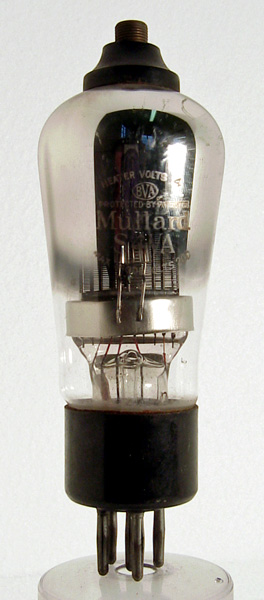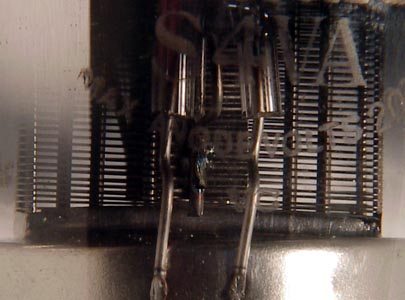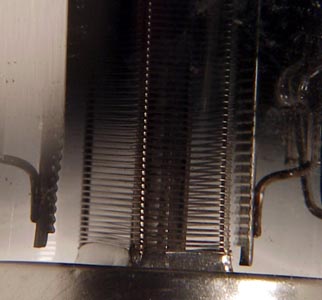|
S4VASensibly equivalent¶ to:See also:
|
|
|

|
The S4VA is a screen grid or tetrode valve. It was available in both clear and metalised versions. The S4VB had a lower anode AC resistance. Both versions were developments of the 1929 S4V.A striking feature of this valve is the small anode plates sited either side of a substantial grid cage, early screen grid valves used this complete screen cage approach.
The vertical wires in the foreground connect to the anode. As can be clearly seen the grid cage has three sets of supports for the three grids, the outer being the screen grid.
In the picture above the separation of the anode plate, left, from the grid cage can be seen.The S4VA and S4VB specimens are typical of earlier Mullard oxide-process AC mains types (late 1920s to mid 1930s). The unsprayed S4VA has a less sophisticated form of assembly than the S23 and still relies on hand assembly using glass bead insulators. The internal skirt connected to the screen grid is a prominent feature of the design. The red-gold colour of the sprayed S4VB, and its unsprung base pins, show that it is relatively early for its type. By the later 1930s Mullard was buying M-OV MS4Bs, spraying them with gold paint, and relabelling them as Mullard S4VAs.The balloon envelope is 46 mm in diameter and, excluding the B5 base pins, is 124 mm tall.References: 1931 data-sheet, 4024 & 1043. Type S4VA was first introduced in 1930. See also 1930 adverts. |
Pin Connections
| 1 | 2 | 3 | 4 | 5 | tc |  g2 | g1 | h | h | k | a |
|
|
Absolute Maximum Operating Conditions¶
| Vh | Ah | Va | Vs | Vg | mAa | mAs | ra | gm | μ | 
| 4.0 | 1.0 | 200 | 80 | -1 | 3.4 | 1.2 | 0.5M | 2.0 | 1,000 |
|
Thanks to Andy Cowley for supplying the above PDF datasheet. |
Updated April 21, 2014.
|
|